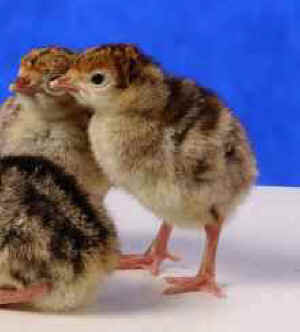
The Mother Turkey and Her Young
An Animal Rights Article from All-Creatures.org
By Karen Davis, PhD,
United Poultry Concerns (UPC)
November 2008
Unlike baby songbirds and raptors, whose parents are absent for long periods gathering food for their young, ground-nesting birds, such as turkeys, stay close to their mothers for months after they are born. Young turkeys, known as "poults," panic if they become separated from their mother.

When a young turkey has wandered away from his family and discovers that he is alone, he gives out a "lost call" _ a loud, persistent shriek of distress. Hearing the cry of her terrified youngster, his mother responds instantly with anxious "yelps," which he answers, and then, "opening his wings, he gives them a joyous flap or two," and with a few sharp, quick yelps of relief, he runs to rejoin his family.

People in modern society have become so used to seeing thousands of young turkeys crowded together in factory farm sheds, awaiting their death, that many are surprised to learn about the lively poults and their mothers chasing grasshoppers in a meadow, sunning themselves and dustbathing together, leaving, as naturalist Joe Hutto writes in "Illumination in the Flatwoods: A Season with the Wild Turkey," "tiny, bowl-shaped impressions the size of small wild turkey bodies."
During their first weeks of life, young turkeys sleep in their ground nest, snuggled in the soft feathers of their mother. After a month or so, they fly at dusk onto a low tree branch where, in the words of John J. Audubon, they "place themselves under the deeply curved wings of their kind and careful parent, dividing themselves for that purpose into two nearly equal parties."
But even after they've taken to roosting in the trees at night, young turkeys stay with their mother, who remains the center of their universe for an additional four or five months, until the next mating season. In 1645, a New England observer reported seeing 60 broods of young wild turkeys with their mothers "on the side of a Marsh, sunning of themselves in a morning betimes."
Turkeys in the commercial food industry have a totally different experience from those who hatch in the nest with their brothers and sisters under their mother's wings. Commercially raised turkeys struggle out of their shells amid thousands of other embryos, in incubator drawers in huge mechanical hatcheries. They never know their mother, because she is locked away somewhere in a breeder facility where a baby turkey's "lost calls," his peeps and trills, will never be heard. The young birds will never know the joy of roaming the woods and fields with her. They will never know the comfort she brings.
Instead, during their first three hours after breaking out of their shells, turkeys in commercial hatcheries undergo a series of painful amputations _ "major surgeries" that, according to the trade journal Turkey World, leave them "traumatized." A recent investigation by the nonprofit group Compassion Over Killing showed how, from the moment of hatching, the turkey poults were "submerged into a world of misery."
The newborn turkeys were dumped out of metal trays, jostled onto conveyer belts after being mechanically separated from cracked eggshells, then sorted, sexed, debeaked and detoed, all without anesthetic. Countless baby turkeys were "mangled from the machinery," suffocated in plastic bags, and dumped into the "same disposal system as the discarded egg shells they were separated from hours earlier."
The mother turkey, meanwhile, has been relegated by the turkey industry to the abject status of a "breeder." This deeply maternal bird, who in nature will pretend to be hurt to distract a predator's attention to herself away from her poults, who will fight with a passion to protect her young that "would make the eagle seem tame," in the words of an awed observer, has been stripped to helplessness.
Instead of mating naturally with a male turkey, the turkey hen is subjected to the ignominy of artificial insemination, from which nearly all commercial turkeys now derive. The artificial insemination of turkeys, known by the industry as "breaking the hens," is graphically depicted in Peter Singer and Jim Mason's book, "The Way We Eat: Why Our Food Choices Matter."
In my own book, More Than a Meal: The Turkey in History, Myth, Ritual, and Reality, I describe the condition associated with artificial insemination known as "deep pectoral myopathy." In it, the terrified "breeder" turkey's chest muscles literally strangle to death in a seizure brought on by the bird's "struggling and wing beating" in the process of being "broken" by the inseminators. The "harvesting" of semen from male turkeys is similarly horrific.
Animal rights advocates are encouraging people to give thanks compassionately this holiday season, with an all-vegetarian feast. As a songwriter once wrote, "A turkey on the table is frightful, but a 'tofurky' with all the trimmings is so delightful." Truly it is.
Return to Animal Rights Articles
Read more at Turkeys - Articles, Poetry,
Videos...







